
The Bottom Line
Introduction

OCZ Storage Solutions, a Toshiba Group Company, is a battle-hardened veteran of the SSD market. OCZ was one of the early pioneers of the client SSD market, and some even credit them as the catalyst that touched off SSD usage in mainstream client applications. Toshiba purchased OCZ in January, addressing OCZ's key weakness by giving them direct access to NAND fabrication. OCZ brings an established retail channel and their controller technology to the relationship.
The Intrepid series consists of the 3600 and 3800 models that are available to OEMs or retail markets. Server-side flash is a booming business and the entrance of the fabs into this segment has upset the old model of deploying client-side SSDs into read-centric applications. Fab-enabled companies can provide enterprise features and firmware at very competitive prices.
The Intrepid SSDs are geared for use in appliances and server-side flash deployments. The 800GB Intrepid 3800 features up to 7.48 PB of endurance for write-intensive applications. The 800GB Intrepid 3600 has up to 1.5 PB of endurance and is geared for read-intensive applications, such as web search, media streaming, indexing, and other general-purpose server-side flash deployments. The primary differentiator between the two SSDs lies in the NAND. Both use Toshiba 19nm Toggle, but the higher-endurance 3800 utilizes eMLC to provide more endurance, while the 3600 utilizes standard MLC.
OCZ has provided enterprise storage solutions in the past with their SandForce-powered Intrepid and Deneva offerings. However, the amount of control OCZ exerted over the firmware was limited. For the new Intrepid series, OCZ utilizes the Marvell SS9187 with OCZ's own proprietary enterprise firmware. This gives OCZ the flexibility required to add more enterprise-centric features and functionality. OCZ also offers the drive with locked firmware, ensuring wide compatibility and intense verification, an important consideration for OEM use.
OCZ has custom controller silicon in use in client applications, and validation and qualification cycles are likely already underway for the enterprise segment. OCZ's Everest 2 platform leverages the hardened Marvell 9187 with organic firmware in their inaugural SSD. The Intrepid offers end-to-end full data path protection via CRC (Cyclic Redundancy Check) as the data traverses the internal buffers and caches. OCZ ensures data integrity with advanced ECC algorithms. The Intrepid also features another layer of protection with an integrated RAID-like parity scheme. These techniques provide a 1 per 10E17 UBER rating.

The Intrepid 3600 has a 6GB/s SATA connection and comes in capacities of 100, 200, 400, and 800 GB in the 2.5" form factor. Performance varies by capacity point, but the 400 GB model we have on the test bench provides a solid 90,000 / 38,000 IOPS of 4k random read/write performance. Sequential speed checks in at 515 / 465 MB/s read/write. A quick glance at the competing SSDs indicates the Intrepid is on the upper end of endurance for the read-intensive class.
Power loss protection (PLP) is an expected characteristic of any enterprise-class offering, and the Intrepid series offers PLP with a unique design. The large AVX supercapacitor offers enough capacitance to flush any data in-flight to the NAND in the event of host power loss. MTBF weighs in at 2,000,000 hours and the drive is 256-bit AES-compliant to fulfill encryption requirements.
OCZ focused on providing exceptional performance and consistent latency for the Intrepid 3000 Series. OCZ's performance consistency focus is important; it delivers big dividends in application performance and RAID environments. The Intrepid is five time faster than the previous-generation Deneva in random write and twice as fast in random read workloads.
Enhanced SMART attributes offer temperature logging and monitoring along with other enterprise-specific attributes. The Intrepid is backed by a five-year warranty with dedicated FAE support. OCZ also offers the StoragePeak 1000 software for management. Let's see how the Intrepid 3600 stacks up against the competition.
PRICING: You can find the OCZ Intrepid 3600 400GB SSD for sale below. The prices listed are valid at the time of writing but can change at any time. Click the link to see the very latest pricing for the best deal.
United States: The OCZ Intrepid 3600 400GB SSD retails for $533.00 at Amazon.
StoragePeak 1000 Management System
Software is a key differentiator during the decision making process. OCZ Storage Solutions provides easy-to-use management utilities for their PCIe SSDs, and also offers the StoragePeak 1000 software to ease management of far-flung flash resources in the datacenter.
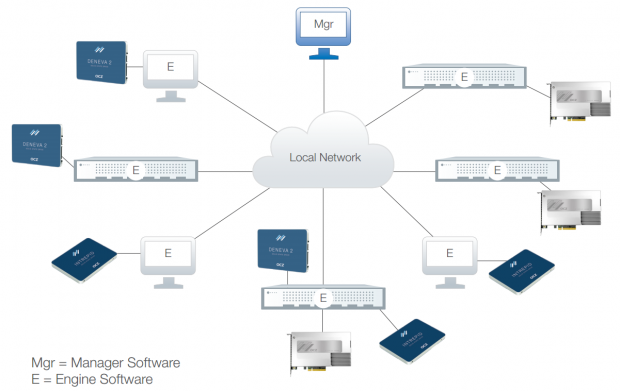
Any IT manager can attest to the frustration of managing distributed resources in a production environment. StoragePeak 1000 addresses this by combining management and maintenance into one central portal for all network connected servers, storage arrays, and appliances. The software is compatible with multiple operating systems like Windows, CentOS, and RHEL.

The software features a friendly and easy-to-use web-based GUI that securely connects to multiple host systems. This centralizes management, monitoring, and reporting to one location. StoragePeak 1000 can manage the Z-Drive 4500 and R4, ZD-XL, Intrepid 3000 series, Deneva 2, and Talos 2 products.
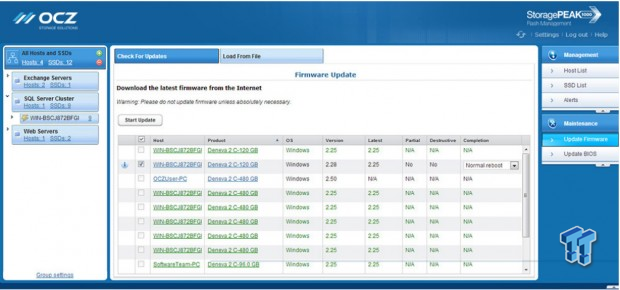
Users can remotely update the firmware or BIOS and secure erase supported products. The system also details and logs important parameters such as remaining life, performance, and SMART data snapshots. Users can configure custom thresholds for critical, warning, and informational alerts. The utility is also available as a powerful CLI application.
OCZ Intrepid 3600 Internals and Specifications
OCZ Intrepid 3600 Internals
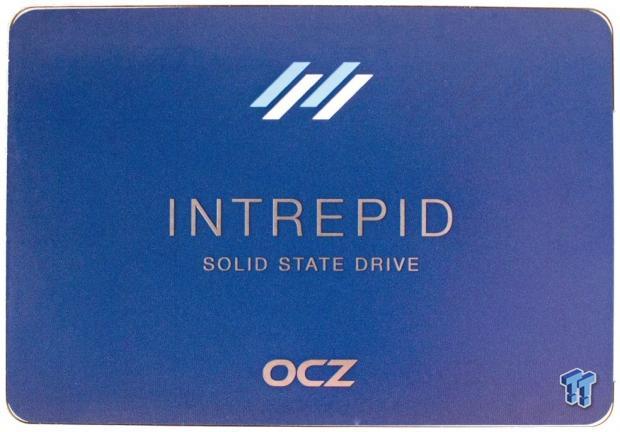
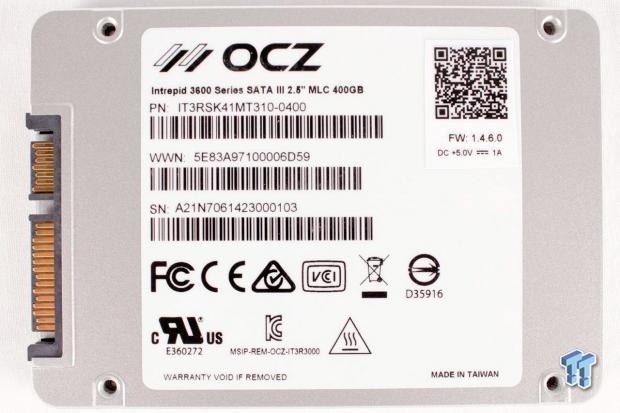
The OCZ Intrepid 3600 comes in the 2.5" form factor with a 9.2mm z-height in a durable alloy case.
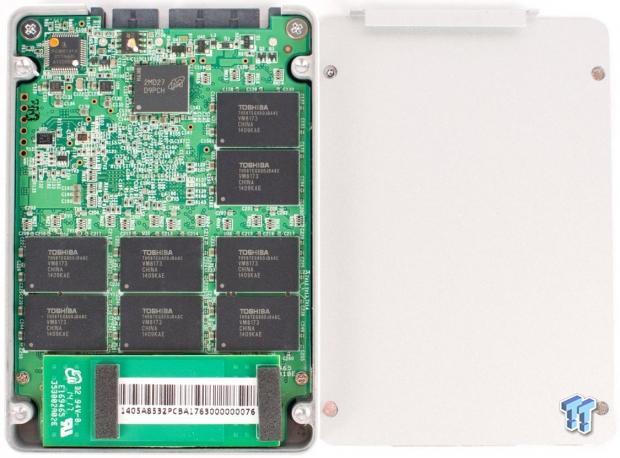
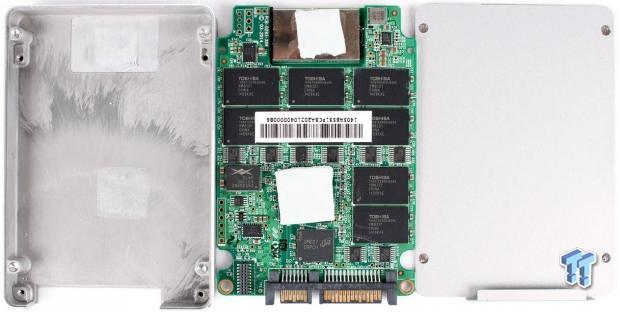
The PCB is secured into the chassis with four additional screws. Further disassembly reveals two thick thermal pads that wick heat away from the controller and capacitor.
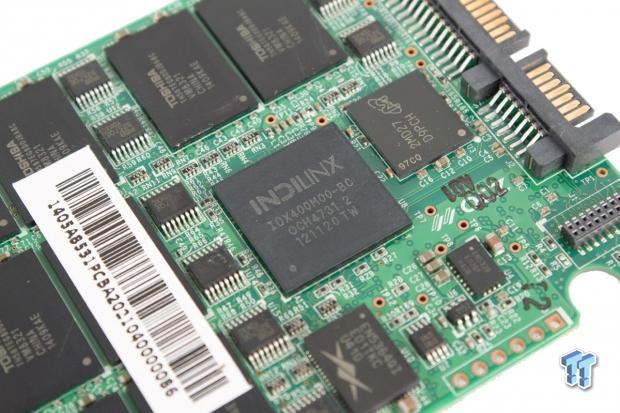
The Indilinx-branded IDX400M00-BC controller is a Marvell 88S9187 with OCZ-proprietary enterprise firmware. The combination of the Marvell controller and OCZ firmware is referred to as the Everest 2 platform. The 8-channel controller features a 6Gb/s SATA interface and support for 16-way interleaving. The Micron DDR3-1333 DRAM chip has a counterpart on the rear of the PCB to provide a total of 1GB of DRAM cache. The beefy AVX supercapacitor protects the contents of the cache during host power-loss events.
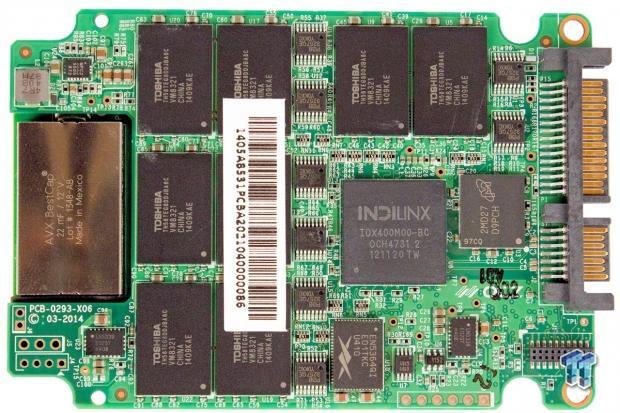
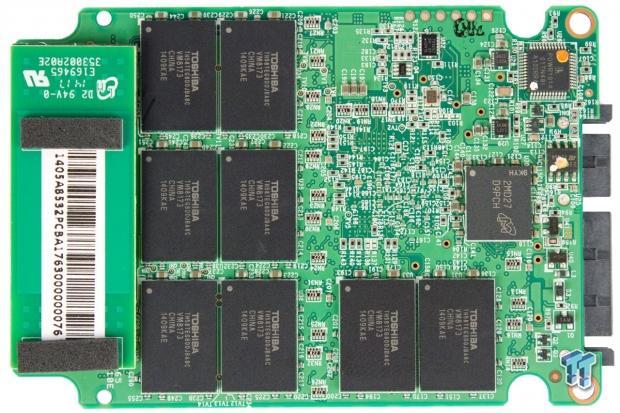
The Intrepid features 16 Toshiba 19nm Toggle TH58TEG8DDJBA8C NAND packages. The large AVX supercapacitor resides on a small daughterboard.
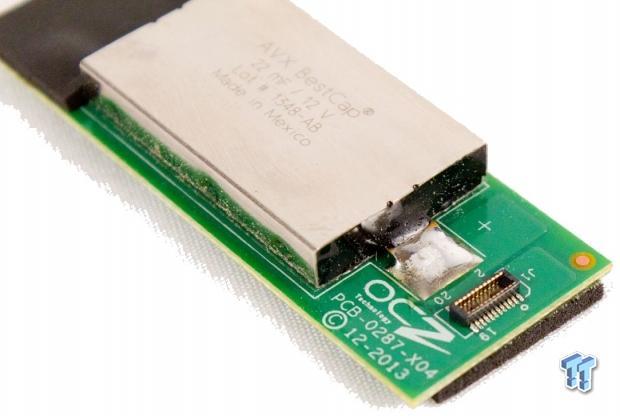
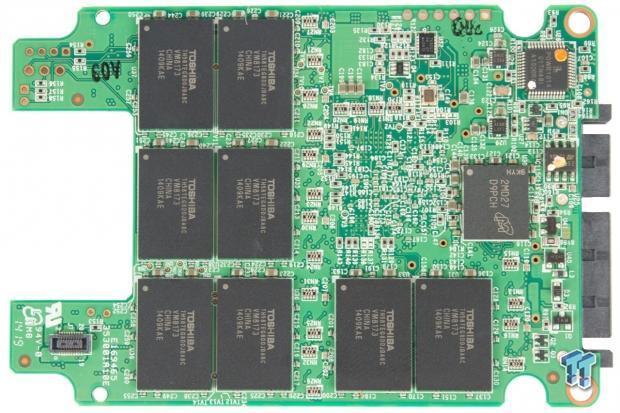
The unique capacitor arrangement comes apart to reveal a small connector that mates the two PCB's. The two PCB's are tightly sandwiched together by the case. Once assembled the tight packaging prevents separation in high-vibration environments.
OCZ Intrepid 3600 Specifications
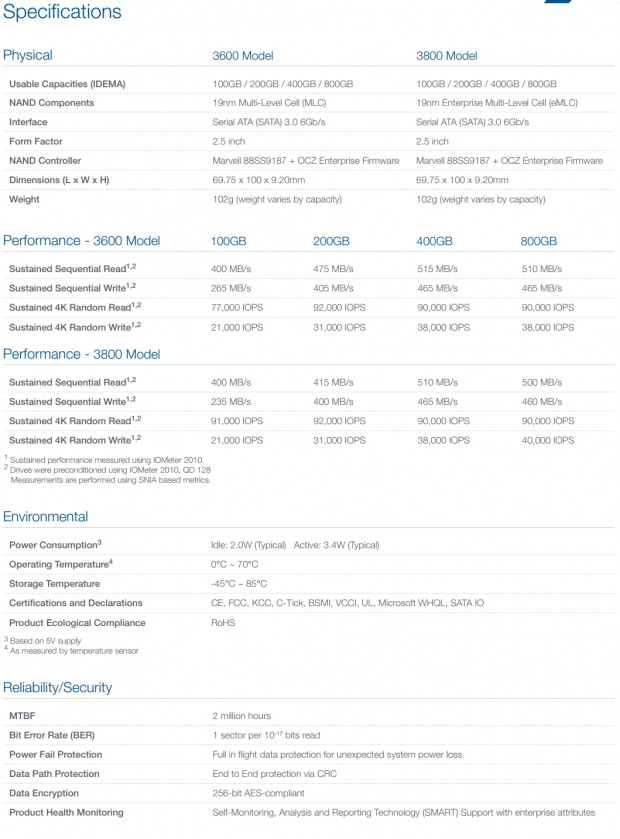
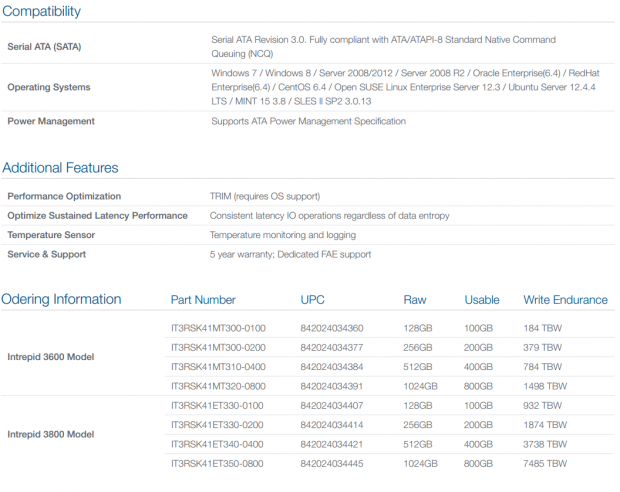
Test System and Methodology
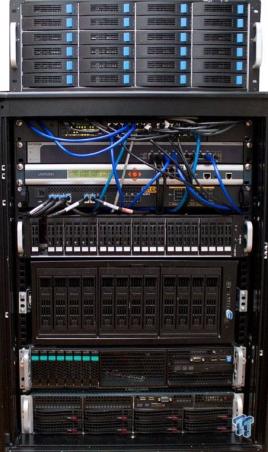

Our approach to storage testing targets long-term performance with a high level of granularity. Many testing methods record peak and average measurements during the test period. These average values give a basic understanding of performance, but fall short in providing the clearest view possible of I/O QoS (Quality of Service).
While under load, all storage solutions deliver variable levels of performance. 'Average' results do little to indicate performance variability experienced during actual deployment. The degree of variability is especially pertinent, as many applications can hang or lag as they wait for I/O requests to complete. While this fluctuation is normal, the degree of variability is what separates enterprise storage solutions from typical client-side hardware.
Providing ongoing measurements from our workloads with one-second reporting intervals illustrates product differentiation in relation to I/O QOS. Scatter charts give readers a basic understanding of I/O latency distribution without directly observing numerous graphs. This testing methodology illustrates performance variability, and includes average measurements, during the measurement window.
IOPS data that ignores latency is useless. Consistent latency is the goal of every storage solution, and measurements such as Maximum Latency only illuminate the single longest I/O received during testing. This can be misleading, as a single 'outlying I/O' can skew the view of an otherwise superb solution. Standard Deviation measurements consider latency distribution, but do not always effectively illustrate I/O distribution with enough granularity to provide a clear picture of system performance. We utilize high-granularity I/O latency charts to illuminate performance during our test runs.
Our testing regimen follows SNIA principles to ensure consistent, repeatable testing, and utilizes multithreaded workloads found in typical production environments. We measure power consumption during precondition runs. This provides measurements in time-based fashion, with results every second, to illuminate the behavior of power consumption in steady state conditions. We also present IOPS-to-Watts measurements to highlight efficiency.
The Intel DC S3500, Samsung 845DC EVO and Micron M500DC feature 480GB of capacity. The OCZ Intrepid is 400GB. The SSDs are tested over their full LBA range to highlight performance at maximum utilization. The first page of results will provide the 'key' to understanding and interpreting our test methodology.
Benchmarks - 4k Random Read/Write
4k Random Read/Write
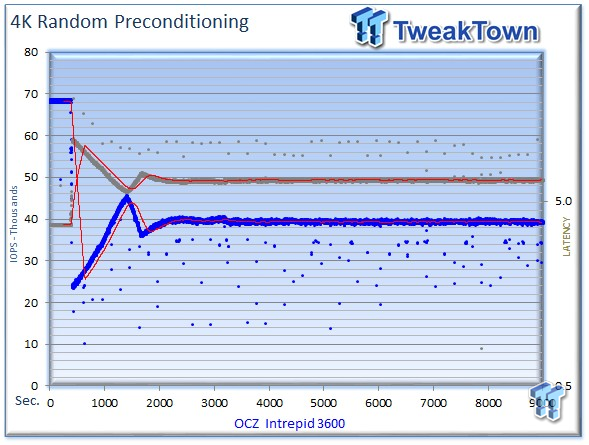
We precondition the 400GB OCZ Intrepid 3600 for 9,000 seconds, or two and a half hours, receiving performance reports every second. We plot this data to illustrate the drives' descent into steady state.
This dual-axis chart consists of 18,000 data points, with the IOPS on the left and the latency on the right. The blue dots signify IOPS, and the grey dots are latency measurements during the test. We place latency data in a logarithmic scale to bring it into comparison range. The lines through the data scatter are the average during the test. This type of testing presents standard deviation and maximum/minimum I/O in a visual manner.
Note that the IOPS and latency figures are nearly mirror images of each other. This illustrates high-granularity testing can give our readers a good feel for latency distribution by viewing IOPS at one-second intervals. This should be in mind when viewing our test results below. This downward slope of performance only occurs during the first few hours of use, and we present precondition results only to confirm steady state convergence.
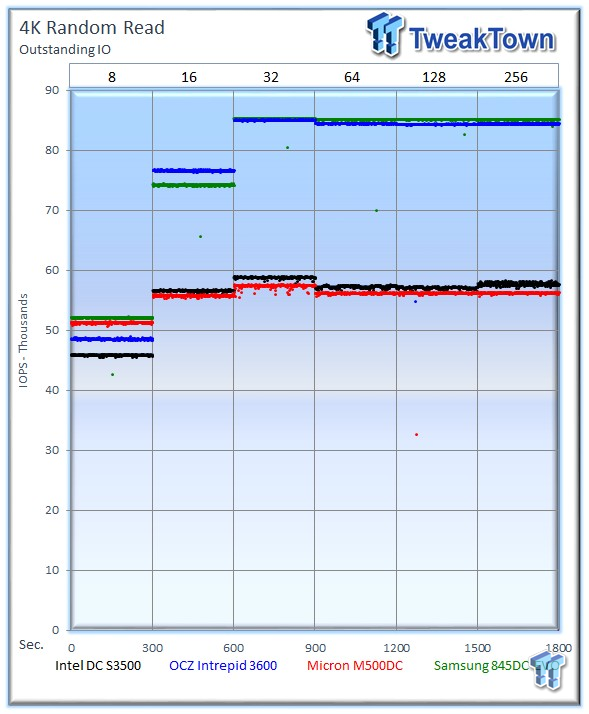
Each level tested includes 300 data points (five minutes of one second reports) to illustrate performance variability. The line for each OIO depth represents the average speed reported during the five-minute interval. 4k random speed measurements are an important metric when comparing drive performance, as the hardest type of file access for any storage solution to master is small-file random. One of the most sought-after performance specifications, 4k random performance is a heavily marketed figure.
The OCZ Intrepid 3600 averages an impressive 84,467 IOPS at 256 OIO (Outstanding I/O), second only to the Samsung 845DC EVO, which delivers 85,155 IOPS. The Micron M500DC averages 56,259 IOPS, and the Intel DC S3500 averages 57,769 IOPS.
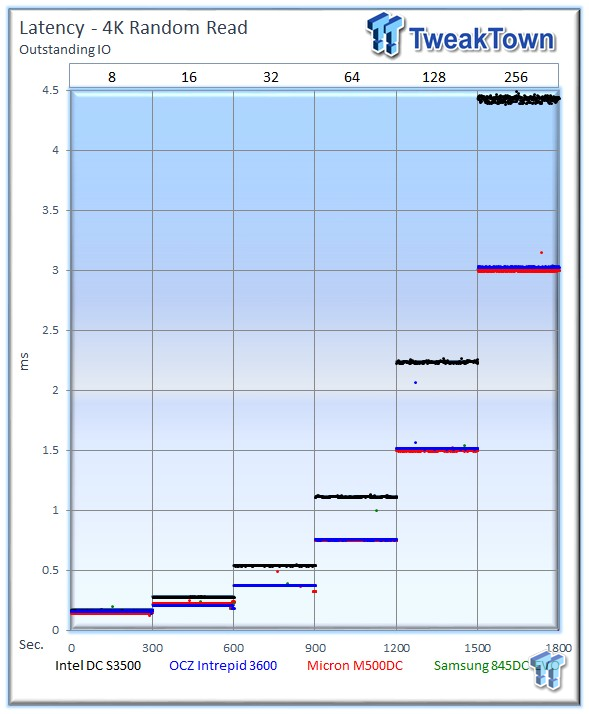
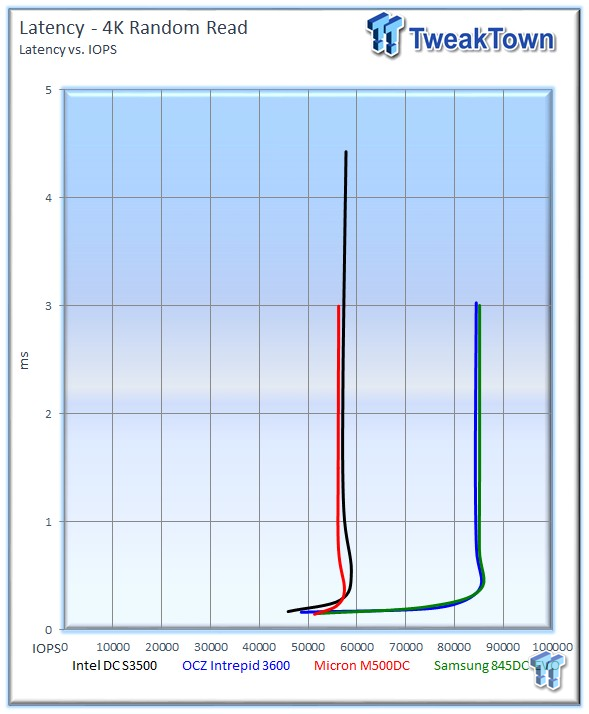
Our Latency vs IOPS charts compare the amount of performance attained from each solution at specific latency measurements. Many applications have specific latency requirements. These charts present relevant metrics in an easy to read manner for readers who are familiar with their application requirements. The SSDs that are lowest and furthest to the right exhibit the most desirable latency characteristics.
The Intrepid nearly matches the 845DC EVO latency. The Intrepid provides nearly 85,000 IOPS at .1ms, the 845's deliver 85,000 IOPS, the DC S3500 provides 57,000 IOPS, and the M500DC provides 56,000 IOPS.
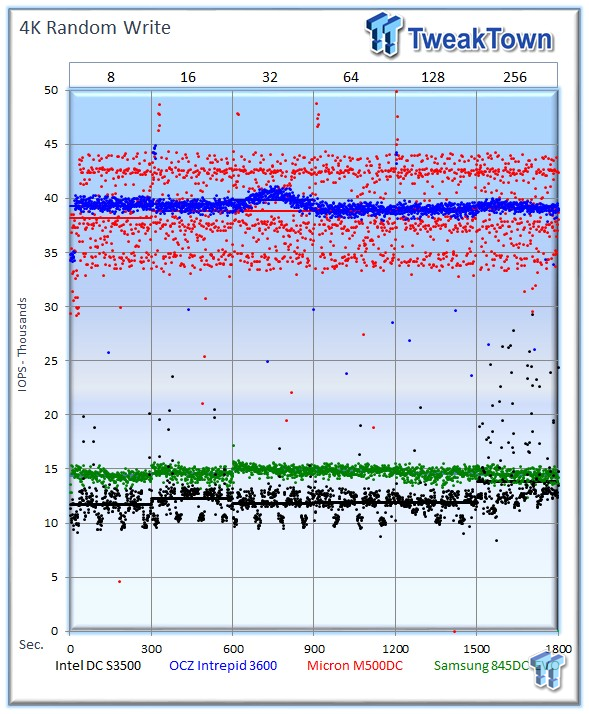
Garbage collection routines are more pronounced in heavy write workloads, leading to performance variability.
The Intrepid averages 39,133 IOPS at 256 OIO, beating the M500DC performance of 39,089 IOPS. Perhaps the most impressive aspect is the very tight performance profile of the Intrepid 3600. The 845DC EVO trails with an average of 13,841 IOPS, near the Intel DC S3500 at the bottom of the chart.

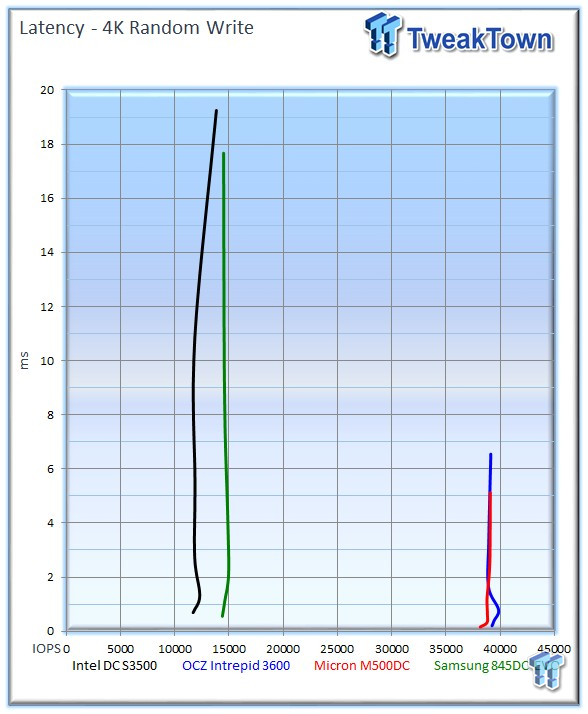
The Intrepid and M500DC trade blows in latency performance, easily separating themselves from the DC S3500 and 845DC EVO. The short length of the bars in the IOPS vs. latency testing is a great testament to the low latency ceiling of the Intrepid 3600 and M500DC.
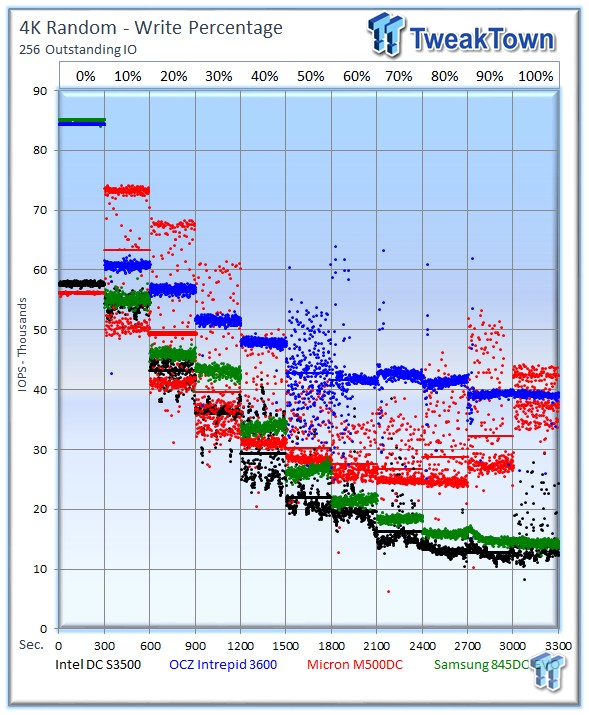
Our write percentage testing illustrates the varying performance of each solution with mixed workloads. The 100% column to the right is a pure 4k write workload, and 0% represents a pure 4k read workload.
The Intrepid blasts through this test with very impressive performance. The M500DC is comes in a close second, but it is hard to deny the strength of the Intrepid in mixed random workloads.
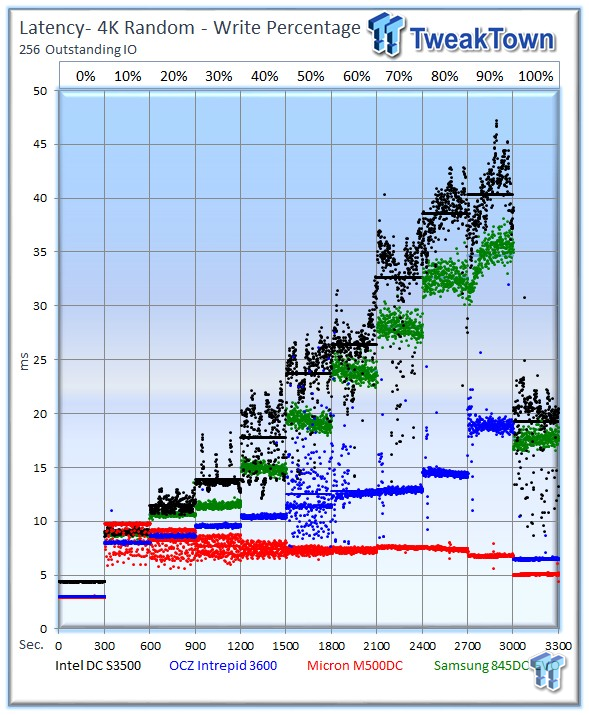
Our mixed workload latency chart reveals the M500DC maintaining the latency edge over the Intrepid in this workload, but the Intrepid easily bests the other two competitors.
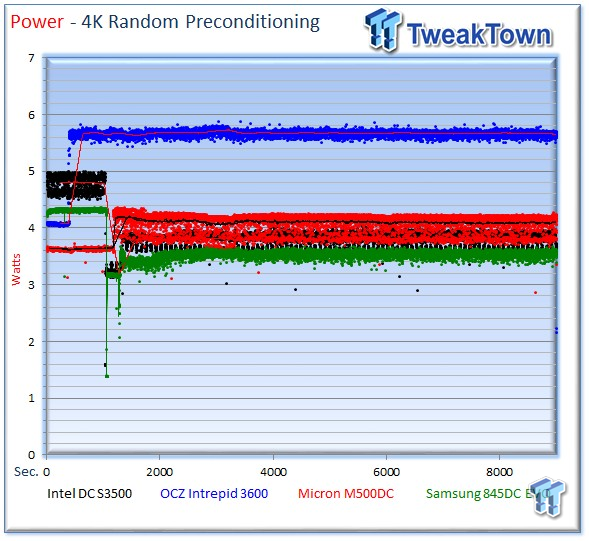
We record power consumption measurements during our precondition run. We calculate the stated average results after the device has settled into steady state during the last five minutes of the test.
The Intrepid averages 5.62 Watts, easily the highest of the SSDs in the test pool. The 845DC EVO averages 3.55 Watts, the M500DC averages 4.09 Watts, and the DC S3500 averages 3.8 Watts during the measurement window.
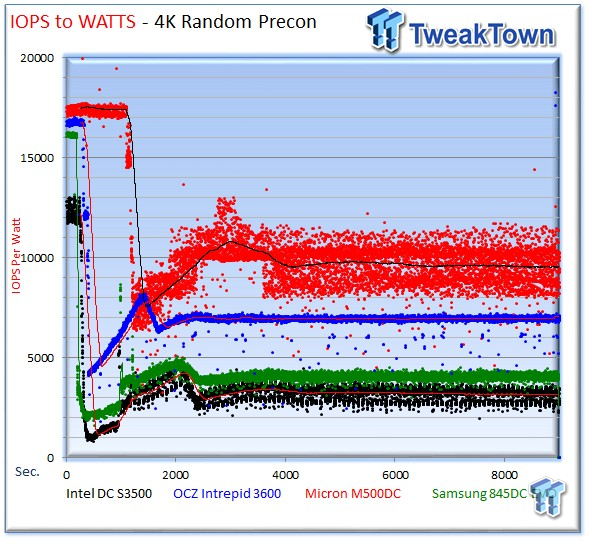
IOPS-to-Watts measurements are generated from data recorded during our precondition run, and the stated average is from the last five minutes of the test.
The Intrepid averages 7,018 IOPS per Watt. The Intrepid's write performance advantage keeps the drive competitive in efficiency measurements in spite of the power consumption. The 845DC EVO averages 3,973 IOPS per Watt, and the M500DC jumps to a big lead, averaging 9,545 IOPS-per-Watt due to its outstanding write performance. The DC S3500 averages 3,125 IOPS per Watt.
Benchmarks - 8k Random Read/Write
8k Random Read/Write
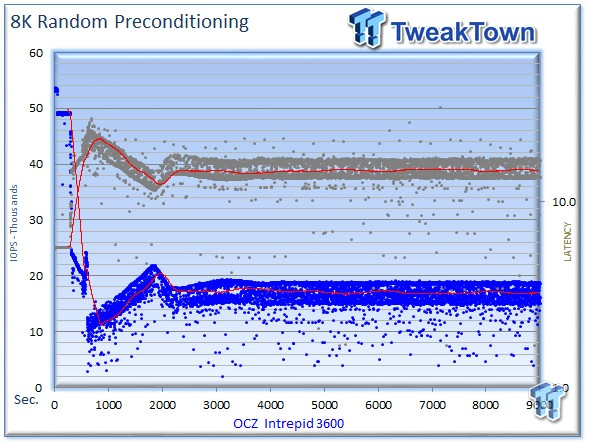
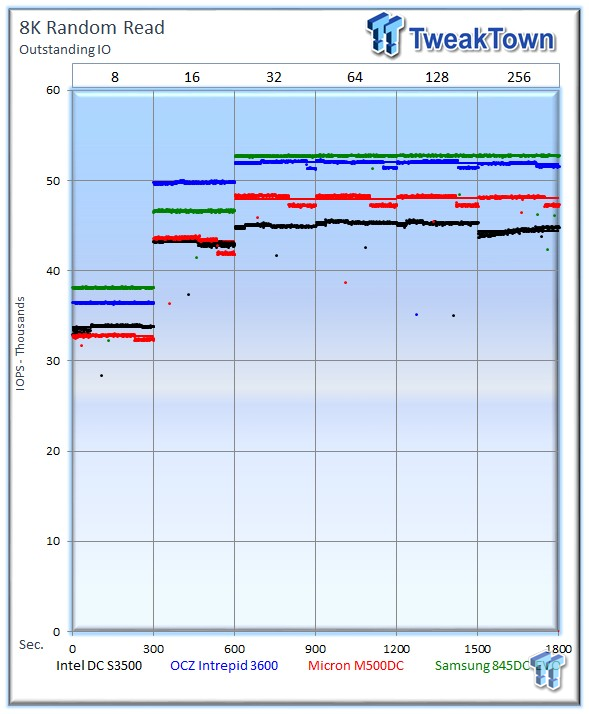
Many server workloads rely heavily upon 8k performance and we include this as a standard with each evaluation. Many of our server workloads also test 8k performance with various mixed read/write distributions.
The average 8K random read speed of the OCZ Intrepid 3600 is 51,859 IOPS at 256 OIO, the Samsung 845DC EVO is 52,731 IOPS, the Micron M500DC is 48,034 IOPS, and the Intel DC S3500 measures 44,444 IOPS.
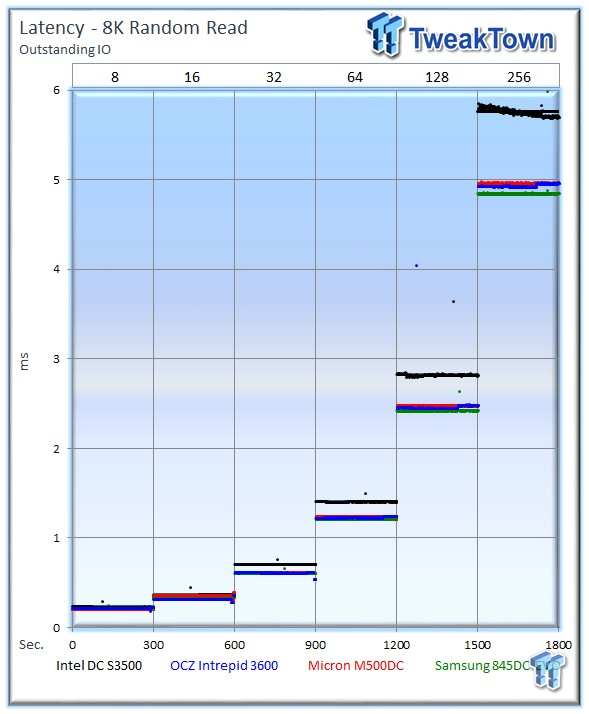
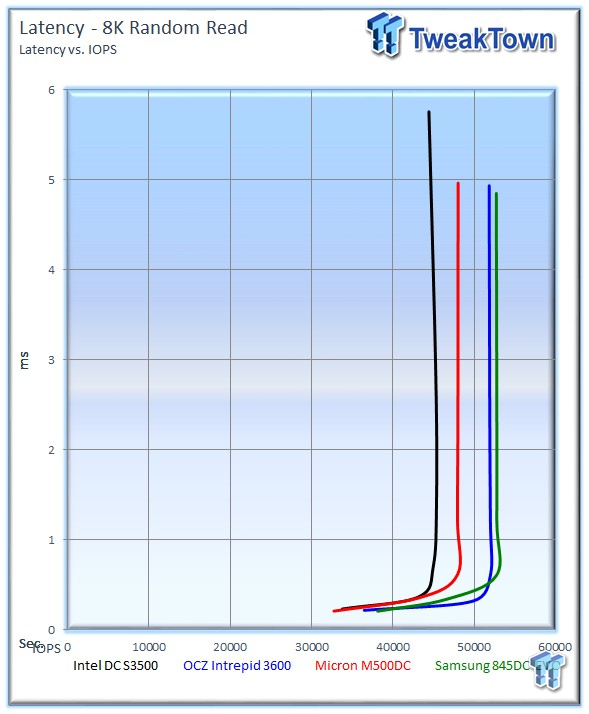
The Intrepid 3600 continues to challenge the 845DC EVO's slight lead.
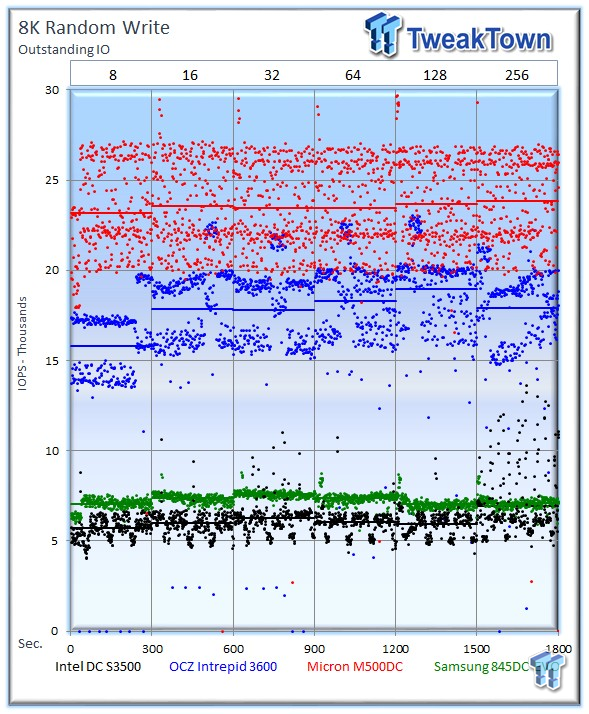
The Intrepid averages 17,898 IOPS, the M500DC easily leads with an average of 23,852 IOPS, the 845DC EVO comes in second with 7,112 IOPS, and the DC S3500 averages 6,937 IOPS.
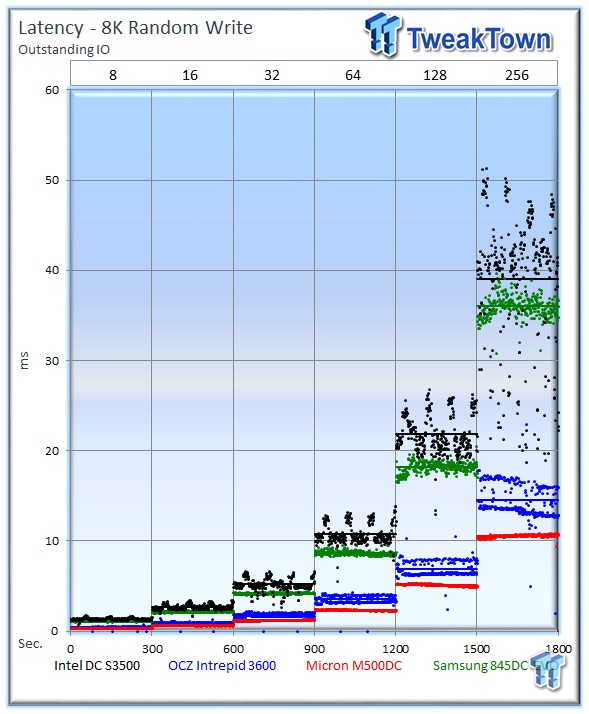

The Intrepid leads the DC S3500 and the 845DC EVO but falls behind the M500DC.
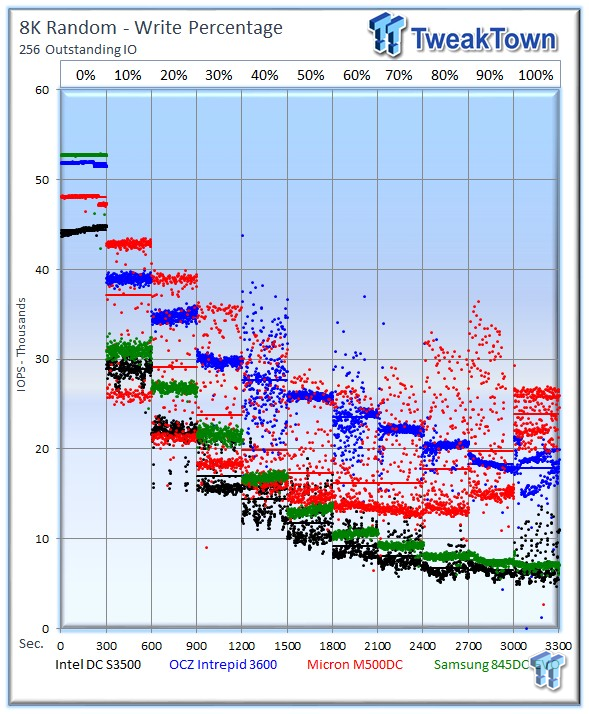
The Intrepid once again wins in overall performance in mixed workload testing. Our latency measurements confirm the same M500DC latency advantage we observed with the 4k mixed workload testing.
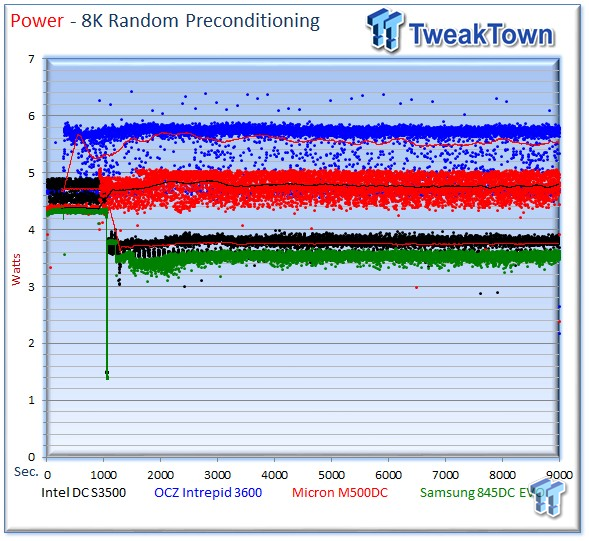
Power consumption for the Intrepid averages 5.51 Watts, the 845DC EVO averages 3.54 Watts, the M500DC averages 4.77 Watts, and the DC S3500 averages 3.75.
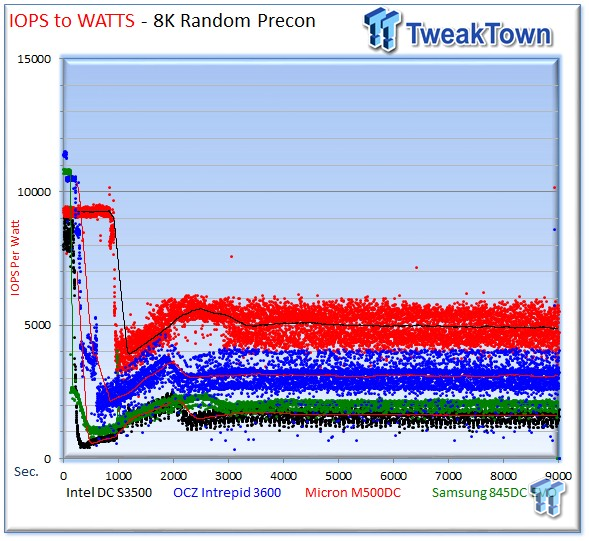
The Intrepid atones for its higher power consumption with an average of 3,097 IOPS per Watt, the M500DC leads the efficiency test with 4,877 IOPS per Watt, the 845DC EVO averages 1,994 IOPS, and the DC S3500 averages 1,584 IOPS per Watt.
Benchmarks - 128k Sequential Read/Write
128k Sequential Read/Write
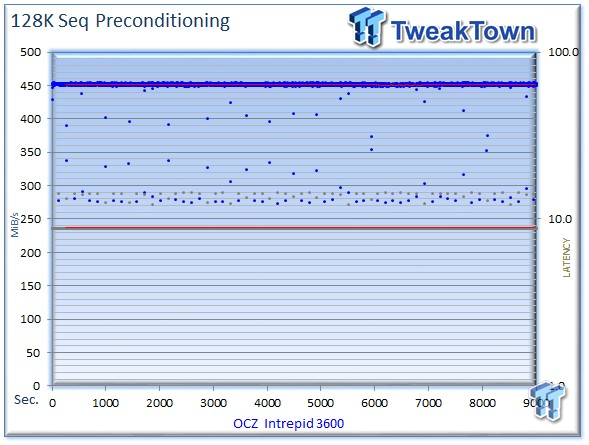

128k sequential speed reflects the maximum sequential throughput of the SSD and is indicative of performance in OLAP, batch processing, streaming, content delivery applications, and backup scenarios.
The Intrepid averages 380 MB/s at 256 OIO. This is below the predicted 515 MB/s in the specifications. This may be due to a differing file test size or methodology, but is still within competitive range of the Micron and Intel drives. The 845DC EVO pulls far ahead with an average of 526MB/s. The Micron M500DC averages 417 MB/s, while the Intel DC S3500 delivers an average of 441 MB/s.
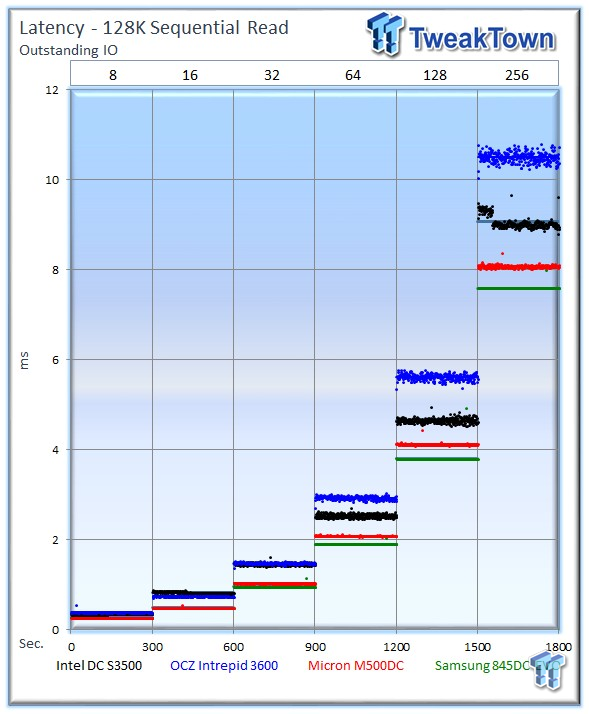
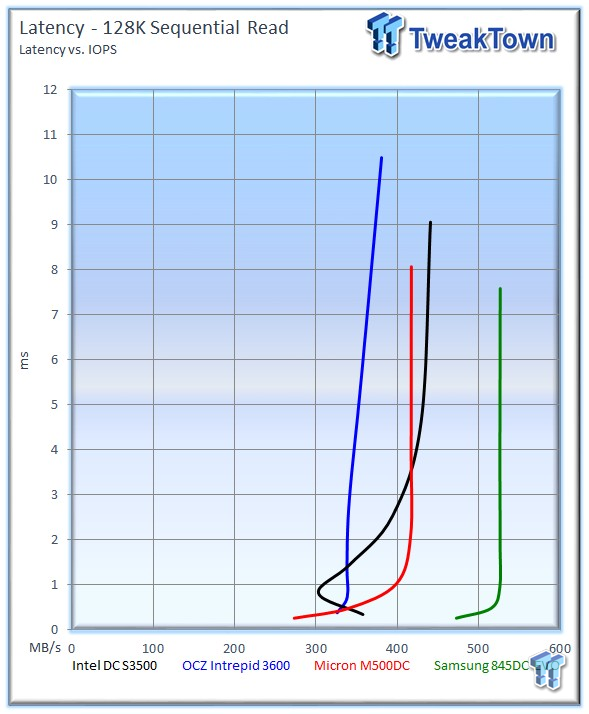
The 845DC EVO provides the lowest overall sequential read latency.
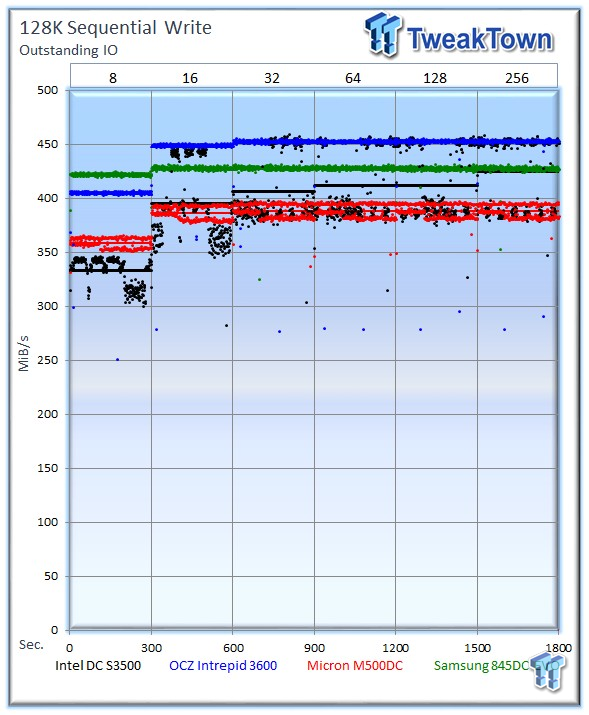
Sequential write performance is important in tasks such as caching, replication, HPC, and database logging. The OCZ Intrepid leads this test with a speed of 451 MB/s. The 845DC EVO trails with 427 MB/s, the M500DC averages 388 MB/s, and the DC S3500 is within striking distance with 424 MB/s.
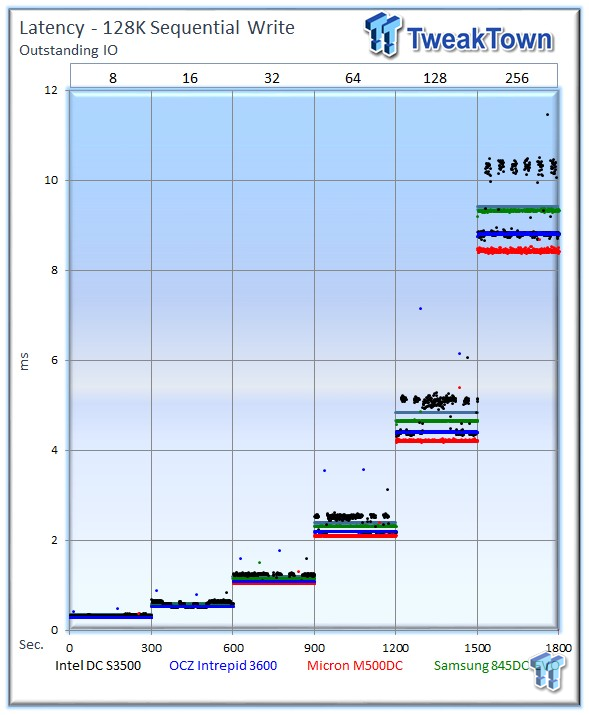
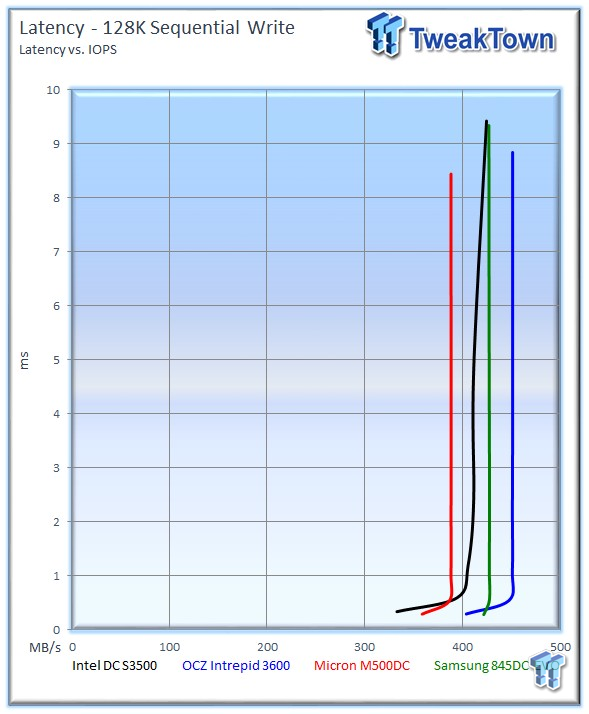
The Intrepid 3600 pulls ahead of the competition in latency performance.
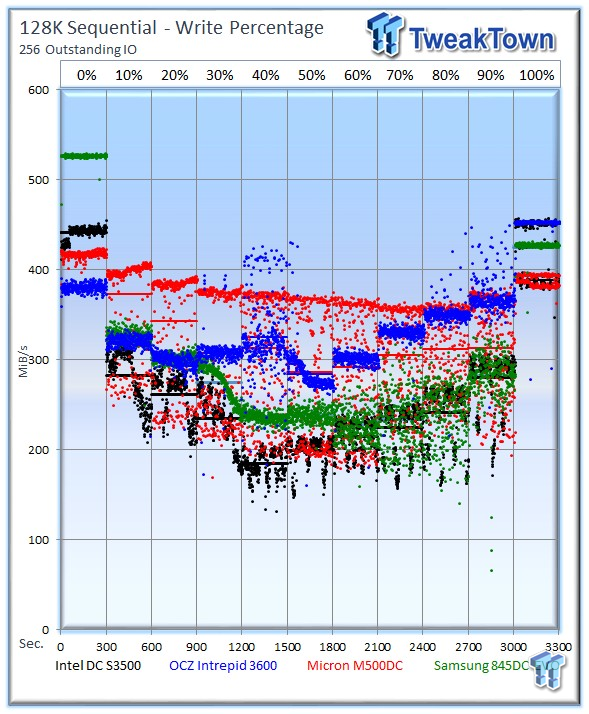
The Intrepid continues its performance run in mixed sequential workloads, but our latency testing revealed a small advantage for the M500DC during the workload.
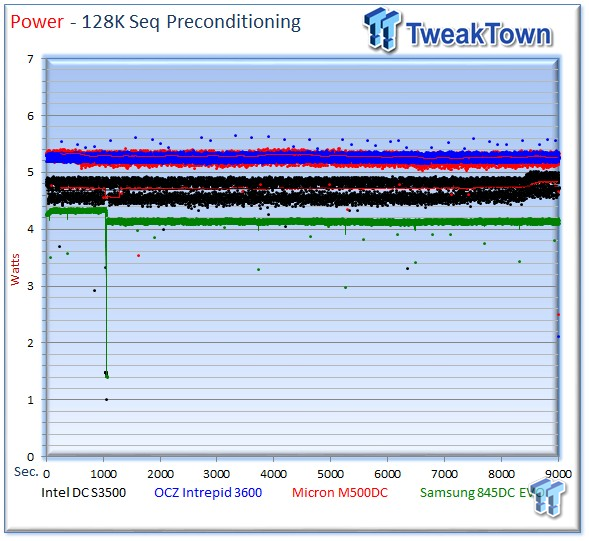
The Intrepid averages 5.26 Watts, the 845 DC EVO averages 4.14 Watts, the M500DC averages 5.24 Watts, and the DC S3500 averages 4.83 Watts.
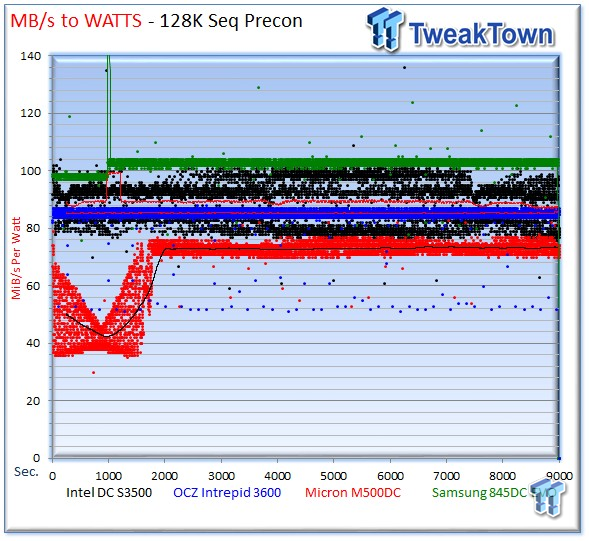
The Intrepid averages 85 MB/s per Watt, the 845DC EVO averages 99 MB/s per Watt, the M500DC averages 73 MB/s per Watt, and the DC S3500 averages 87 MB/s per Watt.
Benchmarks - Database/OLTP and Web Server
Database/OLTP
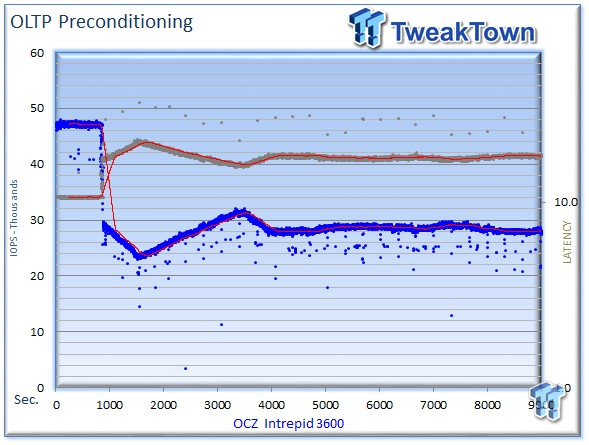
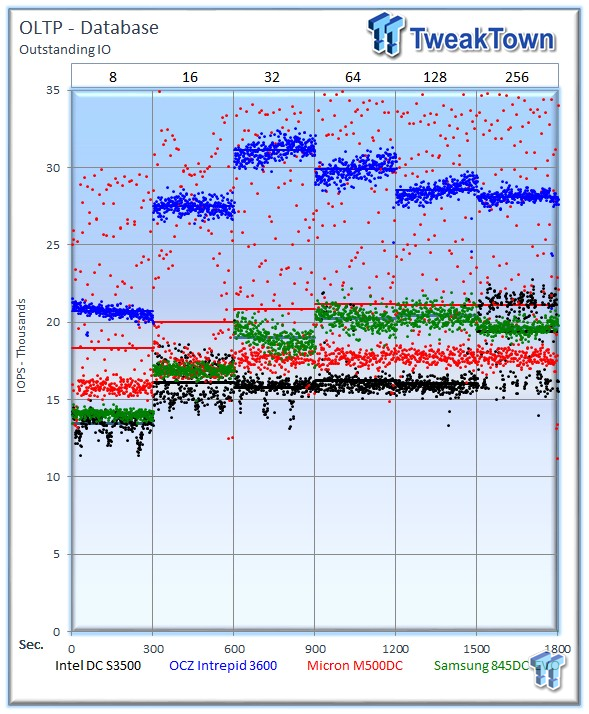
This test consists of Database and On-Line Transaction Processing (OLTP) workloads. OLTP is the processing of transactions such as credit cards and high frequency trading in the financial sector. Databases are the bread and butter of many enterprise deployments. These demanding 8k random workloads with a 66 percent read and 33 percent write distribution bring even the best solutions down to earth.
The Intrepid 3600 dominates this test with an average of 28,094 IOPS and nice consistent performance. The M500DC averages 21,133 IOPS, the Samsung 845DC EVO has a very consistent average of 19,678 IOPS at 256 OIO, and the Intel DC S3500 averages 19,400 IOPS at 256 OIO.
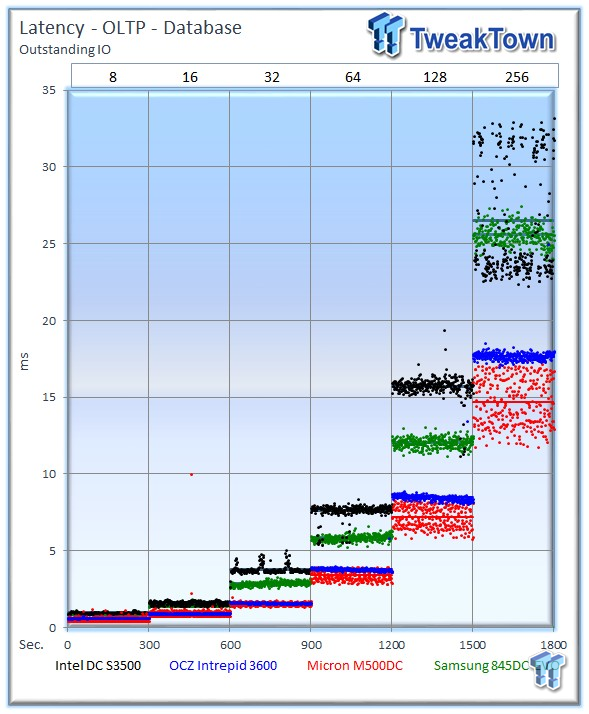
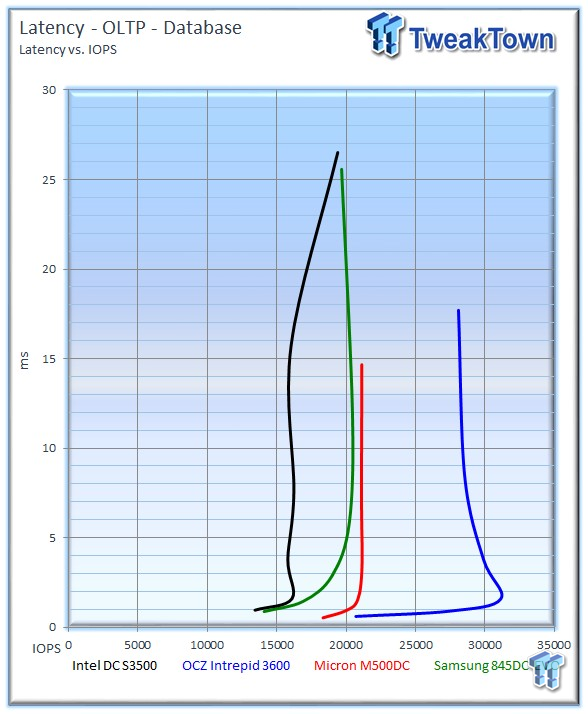
The Intrepid's latency performance is excellent in this workload.
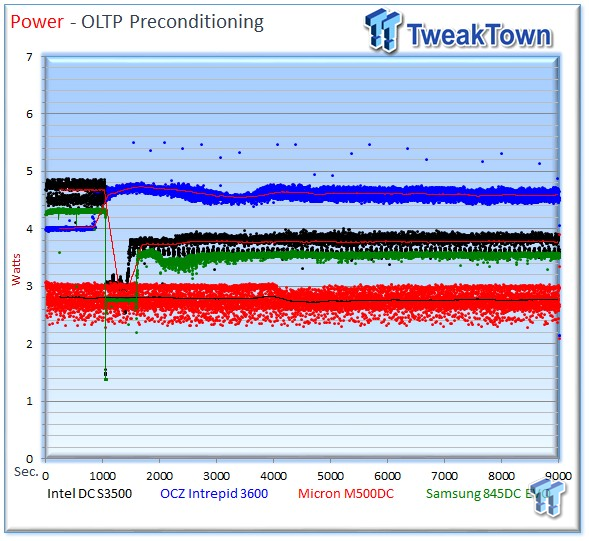
The Intrepid averages 4.57 Watts, the 845DC EVO averages 3.55 Watts, the M500DC averages 2.76 Watts, and the DC S3500 averages 3.76 Watts.
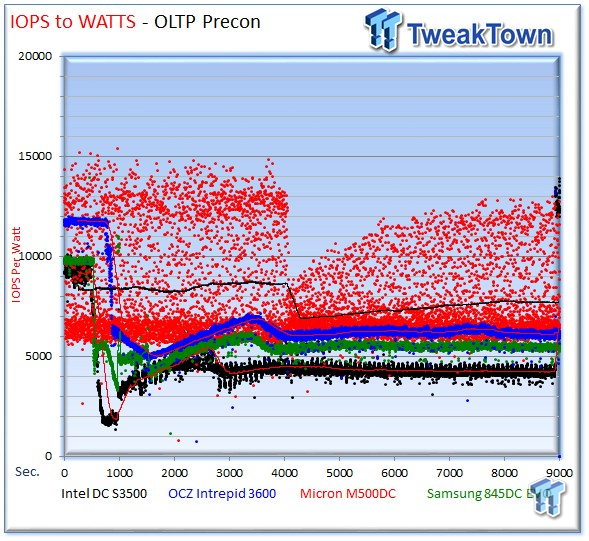
The Intrepid averages 6,153 IOPS per Watt, the 845DC EVO averages 5,465 IOPS per Watt, the M500DC averages 7,676 IOPS per Watt, and the DC S3500 averages 4,040 IOPS per Watt.
Web Server
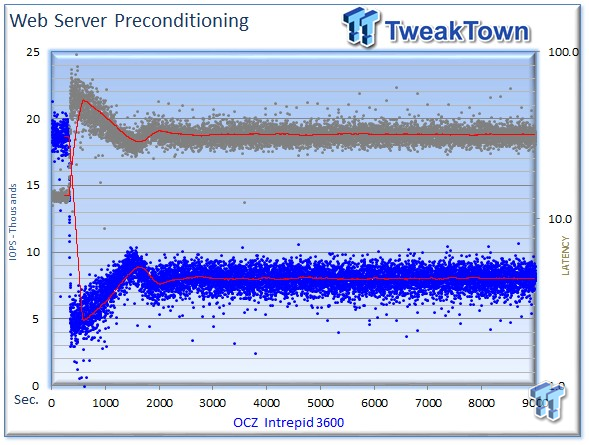
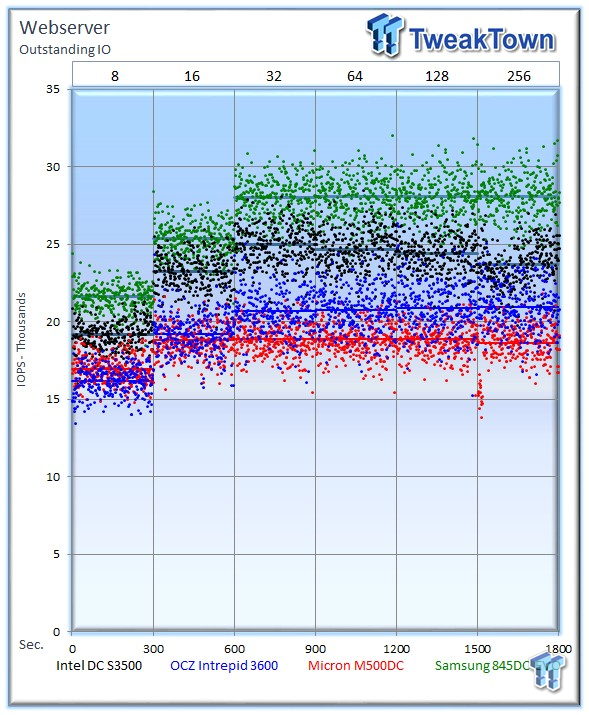
The Web Server workload is read-only with a wide range of file sizes. Web servers are responsible for generating content users view over the Internet, much like the very page you are reading. The speed of the underlying storage system has a massive impact on the speed and responsiveness of the server hosting the website.
The Intrepid averages 20,945 IOPS at 256 OIO, the 845DC EVO averages 28,054 IOPS, and the M500DC averages 18,650 IOPS, falling to the DC S3500 average of 23,664 IOPS.
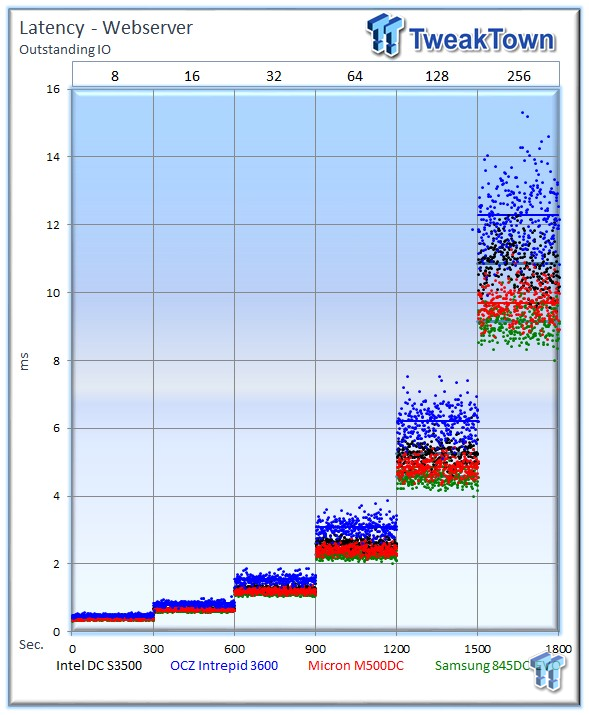
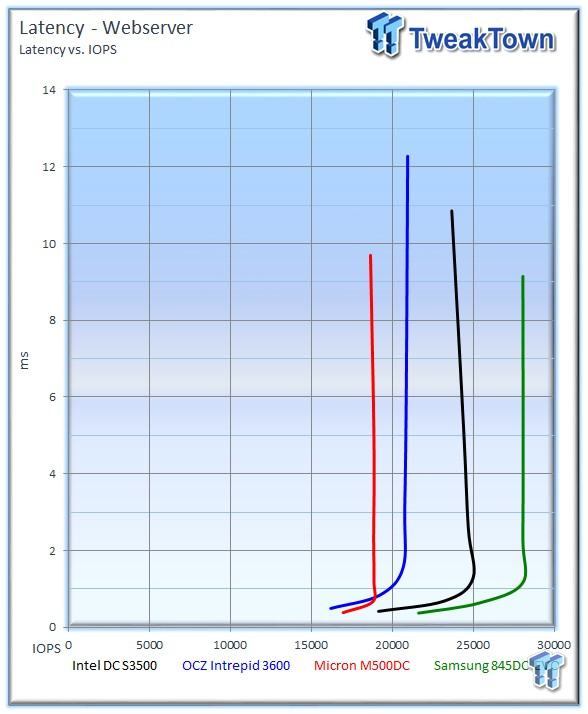
The 845DC EVO pulls ahead in latency vs. IOPS testing.
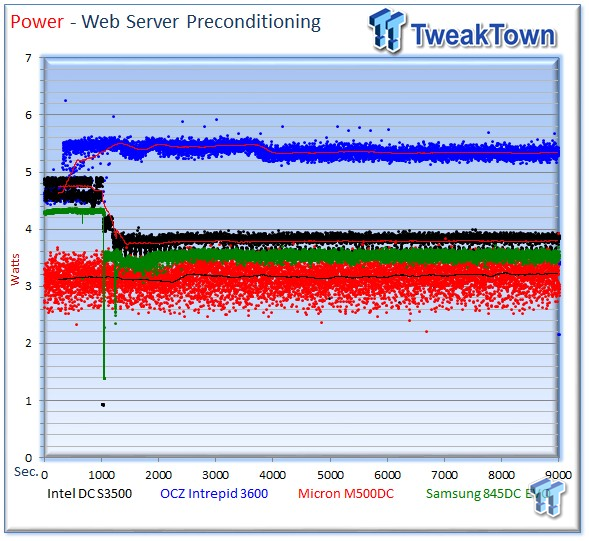
The Intrepid averages 5.29 Watts, the 845DC EVO averages 3.55 Watts, the M500DC averages 3.21 Watts, and the DC S3500 requires 3.8 Watts during the web server workload.
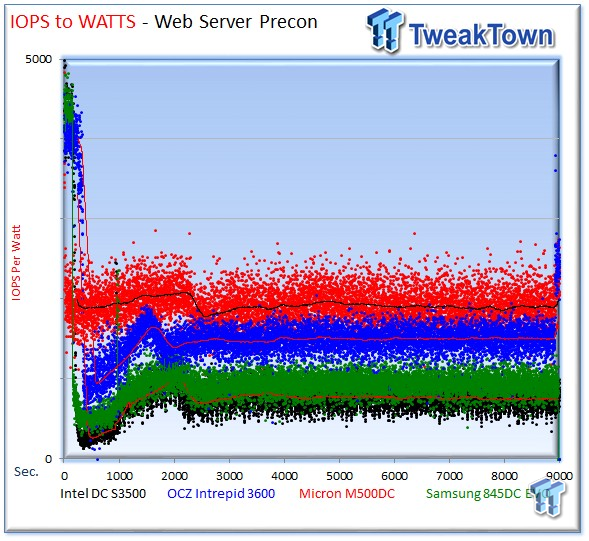
The Intrepid averages 1,703 IOPS per Watt, the 845DC EVO averages 914 IOPS per Watt, and the M500DC scores 1,965 IOPS per Watt, compared to 749 IOPS for the DC S3500.
Benchmarks - Email Server
Email Server
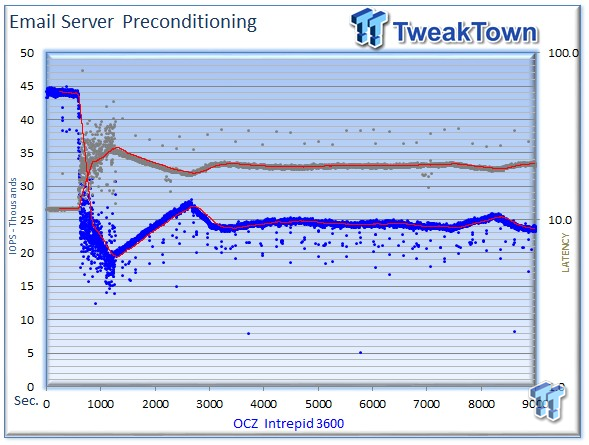
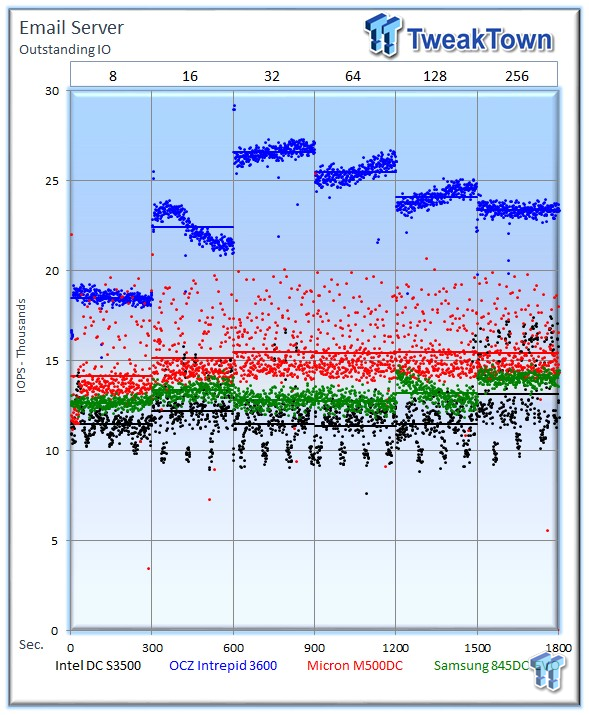
The email server workload is a demanding 8K test with a 50% read and 50% write distribution. This application is indicative of the performance in heavy write workloads.
The Intrepid 3600 owns the workload with an average of 23,391 IOPS, the 845DC EVO averages 14,041 IOPS, the Micron M500DC averages 15,403 IOPS, and the Intel DC S3500 averages 13,121 IOPS at 256 OIO.
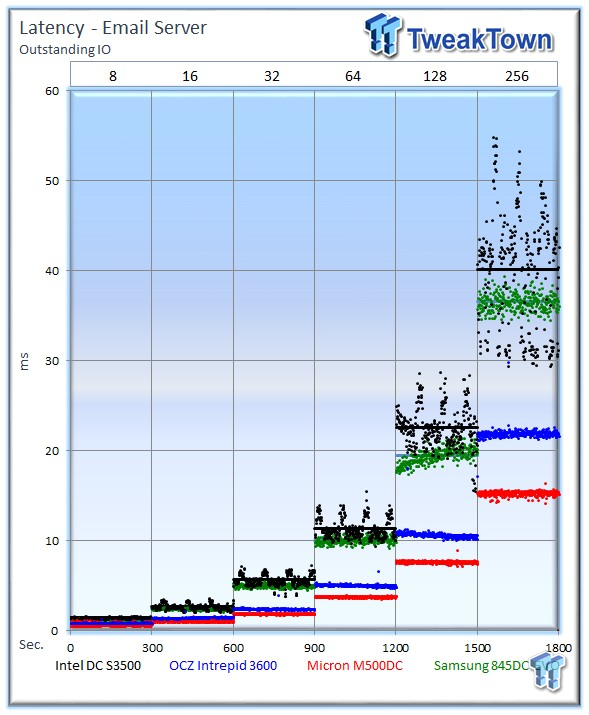
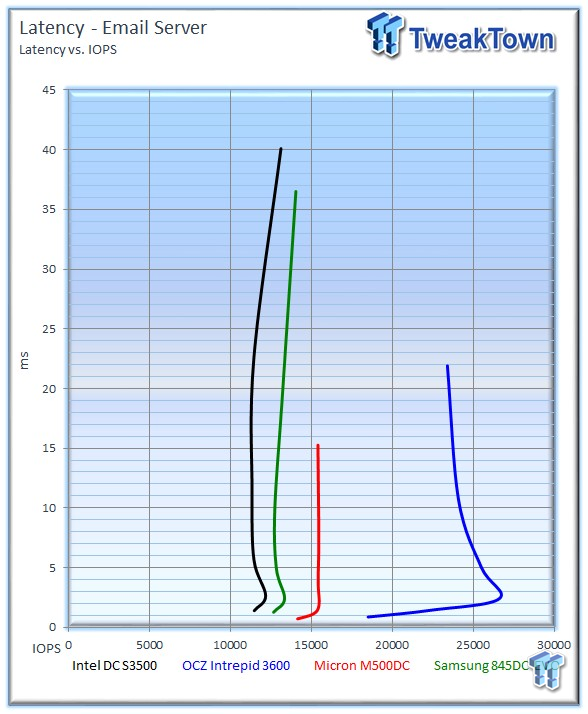
The Intrepid 3600 distances itself from the pack during the measurement window.
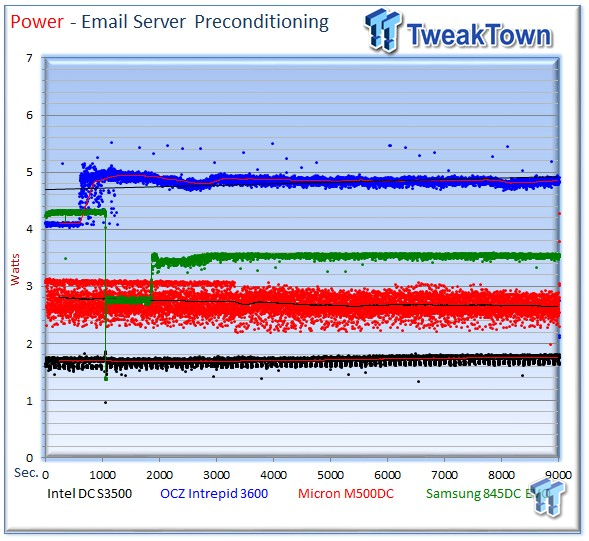
The Intrepid averages 4.82 Watts, the 845DC EVO averages 3.54 Watts, the M500DC averages 2.66 Watts, and the DC S3500 averages 1.75 Watts.
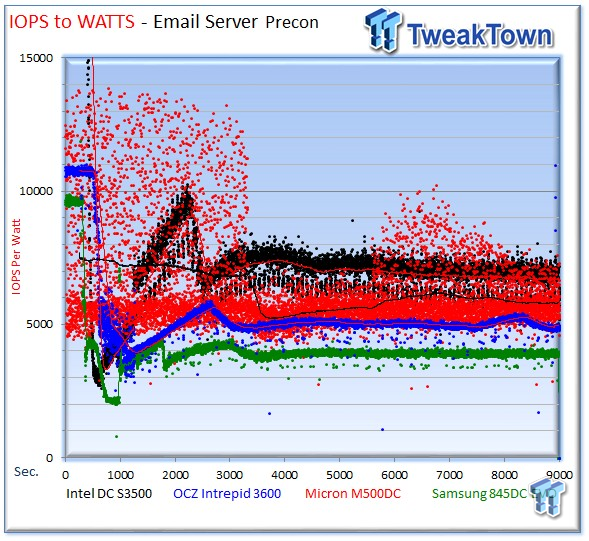
The Intrepid averages 4,939 IOPS per Watt, the 845DC EVO averages 3,815 IOPS per Watt, the M500DC averages 5,806 IOPS per Watt, and the DC S3500 scores 6,705 IOPS per Watt.
Final Thoughts
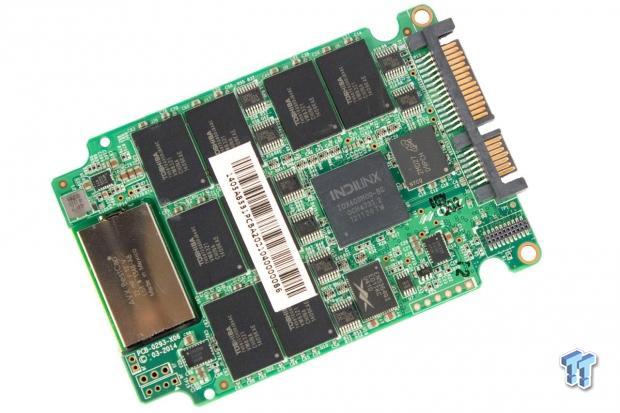
OCZ Storage Solutions' first outing with their proprietary firmware signifies an interim step as they ramp to deploying their own enterprise-class controller silicon. The Intrepid 3600 offers enterprise-specific features, such as enhanced ECC, end to end data-path protection, power loss protection, device-level parity, and locked firmware. StoragePeak 1000 software also provides the ability to centrally manage and maintain OCZ storage products deployed in multiple servers.
OCZ utilizes advanced engineering to deliver more performance and endurance from the Intrepid 3600. We are observing a new class of SSD in the low endurance read-centric segment. The Intrepid's impressive specifications place it into the relatively new performance-oriented read-centric class alongside the Micron M500DC. These two competitors consistently separated themselves from the other SSDs in the test pool.
It is important to note that the Intrepid provides 80GB less user-addressable space than the competing SSD's in the test pool. This lower amount of capacity pays off through chart-topping performance in several of our tests. The OCZ Intrepid 3600 provides strong random read performance only rivaled by the 845DC EVO. In 4k random write testing, the Intrepid led the pack convincingly and provided a much more consistent performance distribution than the runner-up. The Intrepid was edged slightly for the lead in the 8k random write workload, but was able to deliver solid performance within striking distance of the leader.
The Intrepid 3600 also featured the highest power consumption in our test pool. The efficiency measurements offset the higher power consumption and the 3600 actually beat two of the three competitors in IOPS per Watt metrics. The Intrepid easily beat the competition in sequential write testing, but we were unable to match the spec'd sequential read speed, falling short by 85 MB/s. This could be due to a differing test platform or methodology. The Intrepid's sequential read performance came in last with a 128K file size, but was still within striking range of the competition.
Most real-world applications reside in mixed workloads and the Intrepid owned that round of testing in both random and sequential access. This impressive performance carried over to our server workloads, and the Intrepid scored a resounding win in OLTP and email server workloads.
Latency was another bright spot that highlighted the Intrepid's tuning for real-world workloads. The 3600 regularly exhibited excellent latency characteristics.
Overall we came away impressed with the Intrepid 3600. It already has several design wins and Dell has the Intrepid 3600 in stock. Early availability will usually affect pricing and the 3600 is hard to gauge at this point. Amazon and other retailers are selling the 3600 at 20 cents per GB higher than the M500DC, but we advise readers to check pricing regularly for up-to-date information.
The merging of Toshiba and OCZ Storage Solutions will bear fruit for a long time to come, and Toshiba's established OEM relationships will certainly help as OCZ continues forward with the march into the OEM and enterprise market. The OCZ Intrepid 3600 wins the TweakTown Performance Award for the SATA read-centric segment.
PRICING: You can find the OCZ Intrepid 3600 400GB SSD for sale below. The prices listed are valid at the time of writing but can change at any time. Click the link to see the very latest pricing for the best deal.
United States: The OCZ Intrepid 3600 400GB SSD retails for $533.00 at Amazon.
